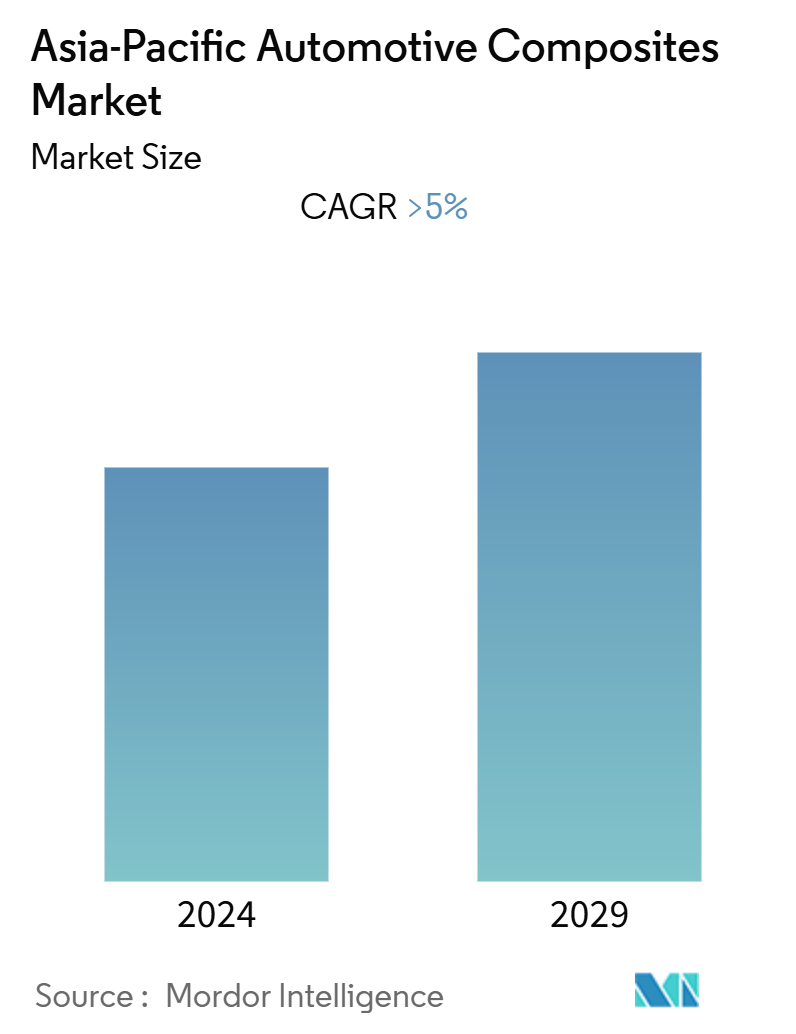Market Size of Asia-Pacific Automotive Composites Industry

| Study Period | 2019 - 2029 |
| Base Year For Estimation | 2023 |
| Forecast Data Period | 2024 - 2029 |
| Historical Data Period | 2019 - 2022 |
| CAGR (2024 - 2029) | 5.00 % |
| Market Concentration | Low |
Major Players
*Disclaimer: Major Players sorted in no particular order |
APAC Automotive Composites Market Analysis
The Asia-Pacific Automotive Composites Market is expected to register a CAGR of greater than 5% during the forecast period.
- The increasing global temperature because of the emission of harmful gases in the atmosphere by automobiles the demand for light weight components are rising as they are more fuel efficient and reduces emission of these gases in the atmosphere.
- Despite the downfall of sales in the passenger and commercial vehicles, the region still is the biggest automobile market in the world. With around 36 million passenger vehicles being sold in the region during the year 2019.
- However, because of the ongoing trade war between United States and China along with the confusion over the emission standards in the region, the growth in automotive sector is slowing down and the automobile sales are expected to witness a downfall for a couple of years until the end of trade tensions.
APAC Automotive Composites Industry Segmentation
The Asia-Pacific Automotive Composites Market is Segmented by Production Type (Hand Layup, Resin Transfer Molding, Vacuum Infusion Processing, and Compression Molding), Material Type (Thermoset Polymer, Thermoplastic Polymer, Carbon Fiber, and Others), Application Type (Structural Assemble, Power Train Components, Interior, Exterior and Others) and Country. Along with the major players, their strategies, innovations, technological advancements and financials are also covered in the report.
| Production Type | |
| Hand Layup | |
| Resin Transfer Molding | |
| Vaccum Infusion Processing | |
| Compression Molding |
| Material Type | |
| Thermoset Polymer | |
| Thermoplastic Polymer | |
| Carbon Fiber | |
| Others |
| Application Type | |
| Structural Assembly | |
| Power Train Components | |
| Interior | |
| Exterior | |
| Others |
Asia-Pacific Automotive Composites Market Size Summary
The Asia-Pacific Automotive Composites Market is experiencing a dynamic phase of growth, driven by the increasing demand for lightweight and fuel-efficient vehicles. This demand is largely fueled by the need to reduce emissions and improve fuel efficiency, as global temperatures rise due to harmful gas emissions from automobiles. Despite a downturn in vehicle sales, the region remains the largest automobile market globally, with significant investments from auto manufacturers in developing innovative composites. These materials, which combine multiple constituents, are crucial in reducing vehicle weight, thereby enhancing safety and fuel efficiency. The market is also witnessing a shift towards recyclable and bio-based composites, aligning with the growing emphasis on sustainability and environmental responsibility.
The market landscape is characterized by a fragmented structure with numerous players holding small market shares. Key companies such as 3B-Fiberglass, Solvay, BASF, and Teijin are actively engaging in strategic partnerships and collaborations to expand their market presence and leverage advanced materials technology. Notable initiatives include joint ventures and partnerships aimed at developing innovative composite solutions, such as the collaboration between Magna and GAC Component Co., Ltd. in China. These strategic moves are designed to meet the rising demand for automobiles both domestically and globally, as well as to capitalize on the region's position as a major exporter of vehicles. The ongoing trade tensions and emission standard uncertainties pose challenges, yet the market continues to evolve with a focus on research and development to drive future growth.
Asia-Pacific Automotive Composites Market Size - Table of Contents
-
1. MARKET DYNAMICS
-
1.1 Market Drivers
-
1.2 Market Restraints
-
1.3 Porters Five Forces Analysis
-
1.3.1 Threat of New Entrants
-
1.3.2 Bargaining Power of Buyers/Consumers
-
1.3.3 Bargaining Power of Suppliers
-
1.3.4 Threat of Substitute Products
-
1.3.5 Intensity of Competitive Rivalry
-
-
-
2. MARKET SEGMENTATION
-
2.1 Production Type
-
2.1.1 Hand Layup
-
2.1.2 Resin Transfer Molding
-
2.1.3 Vaccum Infusion Processing
-
2.1.4 Compression Molding
-
-
2.2 Material Type
-
2.2.1 Thermoset Polymer
-
2.2.2 Thermoplastic Polymer
-
2.2.3 Carbon Fiber
-
2.2.4 Others
-
-
2.3 Application Type
-
2.3.1 Structural Assembly
-
2.3.2 Power Train Components
-
2.3.3 Interior
-
2.3.4 Exterior
-
2.3.5 Others
-
-
Asia-Pacific Automotive Composites Market Size FAQs
What is the current Asia-Pacific Automotive Composites Market size?
The Asia-Pacific Automotive Composites Market is projected to register a CAGR of greater than 5% during the forecast period (2025-2030)
Who are the key players in Asia-Pacific Automotive Composites Market?
3B-Fiberglass, Solvay, Teijin, Gurit and BASF are the major companies operating in the Asia-Pacific Automotive Composites Market.

